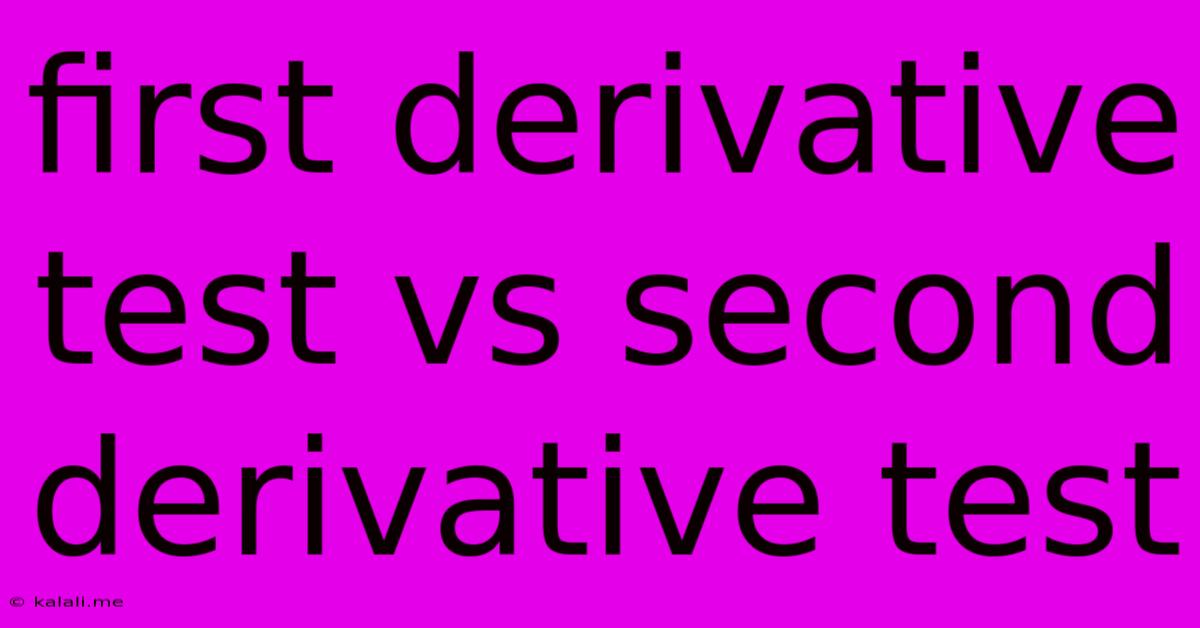First Derivative Test Vs Second Derivative Test
Kalali
May 10, 2025 · 3 min read

Table of Contents
First Derivative Test vs. Second Derivative Test: Which One Should You Use?
Determining the nature of critical points – whether they represent a local maximum, local minimum, or neither – is a crucial task in calculus. Two powerful tools for this are the First Derivative Test and the Second Derivative Test. While both can identify extrema, they differ in their approach and applicability. This article will delve into the nuances of each test, highlighting their strengths and weaknesses to help you choose the most effective method for your problem.
Understanding Critical Points: Before diving into the tests, let's clarify what we mean by critical points. A critical point occurs where the first derivative of a function, f'(x), is equal to zero or undefined. These points are candidates for local maxima, local minima, or saddle points.
The First Derivative Test: A Sign Analysis Approach
The First Derivative Test examines the sign of the first derivative around the critical point. The test proceeds as follows:
-
Find critical points: Determine where f'(x) = 0 or f'(x) is undefined.
-
Test intervals: Choose test points in the intervals created by the critical points.
-
Analyze the sign: Evaluate the sign of f'(x) at each test point.
- f'(x) changes from positive to negative: The critical point is a local maximum.
- f'(x) changes from negative to positive: The critical point is a local minimum.
- f'(x) does not change sign: The critical point is neither a local maximum nor a local minimum (it could be a saddle point or an inflection point).
Advantages of the First Derivative Test:
- Always works: Unlike the Second Derivative Test, it's applicable even when the second derivative is undefined or difficult to compute.
- Provides comprehensive information: It reveals whether a critical point is a local maximum, minimum, or neither, regardless of the concavity of the function.
Disadvantages of the First Derivative Test:
- More computationally intensive: Requires evaluating the first derivative at multiple test points.
- Can be less efficient: If the second derivative is easily calculable, the Second Derivative Test can be quicker.
The Second Derivative Test: A Concavity Approach
The Second Derivative Test uses the concavity of the function at the critical point, determined by the second derivative, f''(x).
-
Find critical points: Determine where f'(x) = 0. Note: This test is only applicable when f'(x) = 0; it cannot handle cases where f'(x) is undefined.
-
Evaluate the second derivative: Calculate f''(x) at each critical point.
-
Analyze the sign:
- f''(x) > 0: The critical point is a local minimum.
- f''(x) < 0: The critical point is a local maximum.
- f''(x) = 0: The test is inconclusive; use the First Derivative Test.
Advantages of the Second Derivative Test:
- Often simpler: If the second derivative is easily computed, this test can be faster than the First Derivative Test.
- Direct conclusion: Provides a direct classification of the critical point when the test is conclusive.
Disadvantages of the Second Derivative Test:
- Limited applicability: It only applies to critical points where f'(x) = 0 and f''(x) is defined. It fails when f''(x) = 0 or is undefined.
- Inconclusive results: Provides no information when f''(x) = 0; further analysis, such as the First Derivative Test, is needed.
Choosing the Right Test
The choice between the First and Second Derivative Tests depends on the specific problem.
-
Use the Second Derivative Test: If calculating the second derivative is straightforward, and it's defined and non-zero at the critical point, this is generally the quicker option.
-
Use the First Derivative Test: If the second derivative is difficult to compute, undefined at the critical point, or if the second derivative is zero at the critical point, the First Derivative Test is the more reliable method. It's also the go-to method when dealing with critical points where the first derivative is undefined.
By understanding the strengths and limitations of both tests, you can confidently navigate the process of identifying and classifying critical points, leading to a more comprehensive understanding of function behavior. Remember to always check for the conditions of each test before applying it.
Latest Posts
Latest Posts
-
Prevent An Expressway Emergency By Merging Without
Jul 12, 2025
-
How Many Grams Of Sugar In A Pound
Jul 12, 2025
-
7am To 11am Is How Many Hours
Jul 12, 2025
-
If Your 35 What Year Was You Born
Jul 12, 2025
-
How Many Cups Is 1 Pound Of Cheese
Jul 12, 2025
Related Post
Thank you for visiting our website which covers about First Derivative Test Vs Second Derivative Test . We hope the information provided has been useful to you. Feel free to contact us if you have any questions or need further assistance. See you next time and don't miss to bookmark.